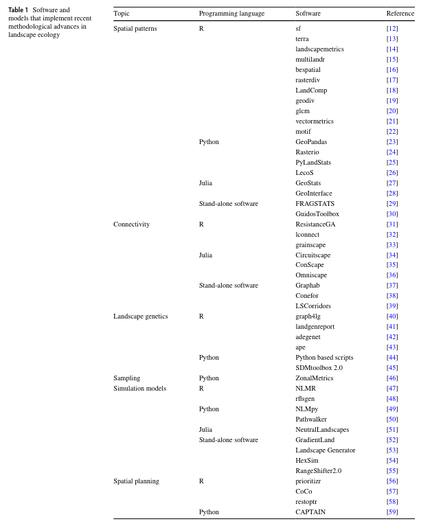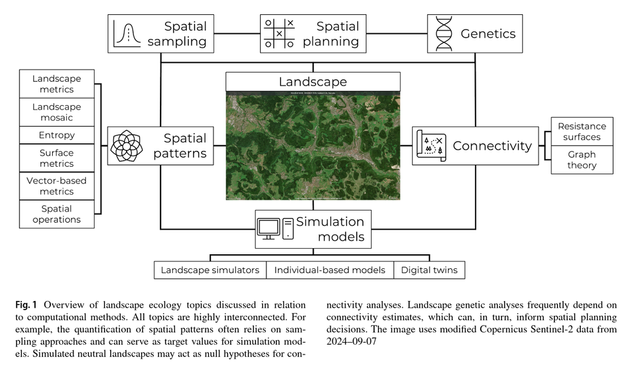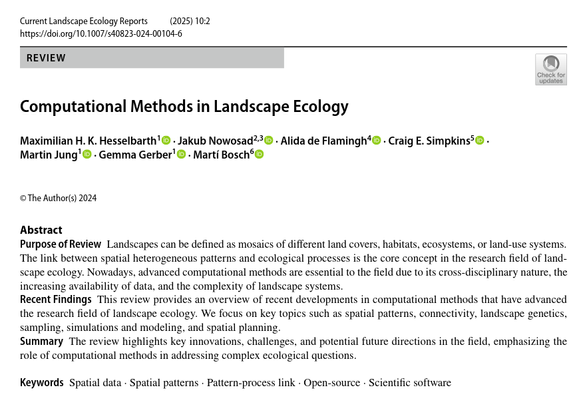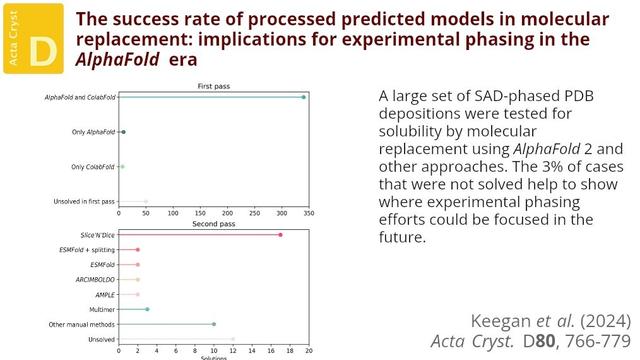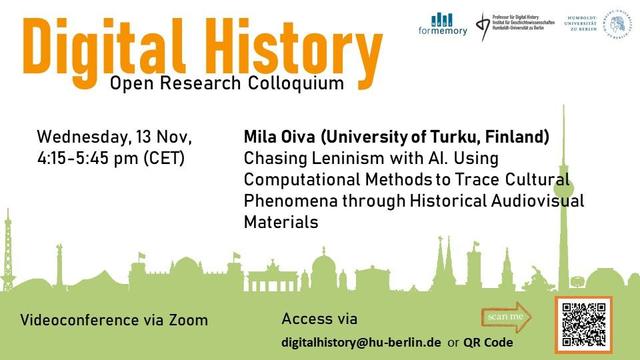Call for Proposals (English ed...
Call for Proposals (English ed...
This review provides an overview of recent developments in computational methods in #LandscapeEcology
It covers topics like spatial patterns, connectivity, landscape genetics, and more.
Read the full paper: https://buff.ly/41xU6wx
Computational Methods in Landscape Ecology - Current Landscape Ecology Reports
Purpose of Review Landscapes can be defined as mosaics of different land covers, habitats, ecosystems, or land-use systems. The link between spatial heterogeneous patterns and ecological processes is the core concept in the research field of landscape ecology. Nowadays, advanced computational methods are essential to the field due to its cross-disciplinary nature, the increasing availability of data, and the complexity of landscape systems. Recent Findings This review provides an overview of recent developments in computational methods that have advanced the research field of landscape ecology. We focus on key topics such as spatial patterns, connectivity, landscape genetics, sampling, simulations and modeling, and spatial planning. Summary The review highlights key innovations, challenges, and potential future directions in the field, emphasizing the role of computational methods in addressing complex ecological questions.
#DigitalArtHistory #ComputationalMethods
https://docs.lib.purdue.edu/cgi/viewcontent.cgi?article=1350&context=artlas
The success rate of processed predicted models in molecular replacement: implications for experimental phasing in the AlphaFold era
A large set of SAD-phased PDB depositions were tested for solubility by molecular replacement using AlphaFold2 and other approaches. The 3% of cases that were not solved help to show where experimental phasing efforts could be focused in the future.
❔How can we use #ComputationalMethods to investigate cultural-historical phenomena in audiovisual sources?
👉 Mila Oiva (University of Turku) will provide answers to this question this week in her talk at our #DigitalHistoryOFK. Based on various research projects on Soviet newsreels (1945-1992), she will discuss the possibilities & limitations of using digital methods for analysing historical audiovisual sources.
🔜 13 Nov, 4-6 pm (CET), online
ℹ️ https://dhistory.hypotheses.org/8886
Mila Oiva: Chasing Leninism with AI. Using Computational Methods to Trace Cultural Phenomena through Historical Audiovisual Materials
How can we trace intangible historical phenomena, such as worldviews, cultural representations, or cultural-political movements through large-scale audiovisual archives? While the hermeneutic tradition of close reading has long provided a foundation for analyzing small-scale historical materials, the rise of digital sources presents new challenges and opportunities. When engaging with vast datasets, the intuitive processes of … „Mila Oiva: Chasing Leninism with AI. Using Computational Methods to Trace Cultural Phenomena through Historical Audiovisual Materials“ weiterlesen
#AIArt #DigitalHumanities #CreativeProcess #AIResearch #DigitalArtHistory #ComputationalMethods #Research
https://dahj.org/article/exploratory-dialogue-with-ai
Exploratory Dialogue with AI: Essay Based on AI Drift Methodology — DAHJ
AI has the potential to transform the art world and the way artists work and produce. However, working with and understanding AI, as a creation tool, raises a series of questions in relation to its internal functioning, its ethical implications, and how human critical capacity intervenes in the man-
Wir freuen uns über tolle Bewerbungen: Webentwicklung, XML-Technologien und Inschriftenforschung, 7 Jahre, Vollzeit/Teilzeit an der #digicademy und der #uni_muenster
„Does Data Science Enrich Art History?“
Together with Clarisse Bardiot, I will discuss this question on 17th November 2023.
#ArtHistory #DigitalArtHistory #ComputationalMethods #AcademicDialogue #DataScience #CulturalDataScience
https://www.harald-klinke.de/events/does-data-science-enrich-art-history
Does Data Science Enrich Art History? — Harald Klinke
The Artl@s Lectures for the 2023-2024 academic year focus on "Narrowing the Divide: A Dialogue between Art History and Digital Art History." Digital Art History is emerging as a distinct discipline but faces challenges in generating meaningful insights due to a gap between computational me
To all comm scholars who are ICA members:
Don't forget to vote! ICA-wide elections are open until Oct 11.
For the #ComputationalMethods Division you can elect your new Vice Chair and International Liaison. We have candidates this year from four continents.
Go here to vote: https://icahdq.org/page/Election2023
Empfehlung für alle, die einen Einstieg in die #ComputationalMethods suchen: Computational Methods für die Sozial- und Geisteswissenschaften von @jajue und @ChantalGrtnr. #openaccess
